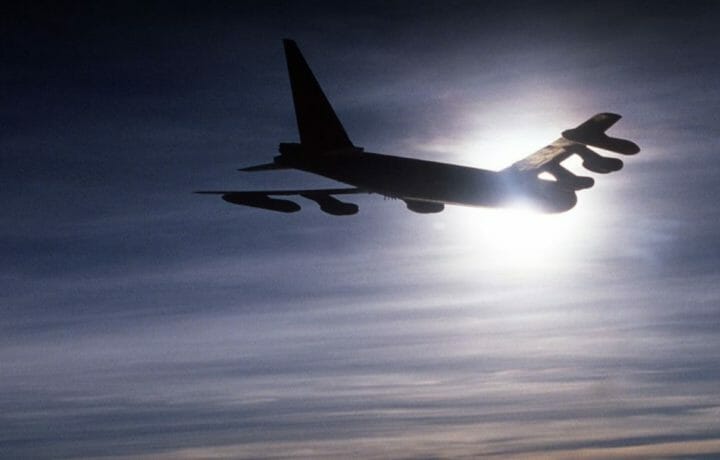While the B-52 Stratofortress bomber has been in active service with the United States Air Force since 1955 it isn’t likely to be retired anytime soon. In fact, the USAF has announced that with upgrades the versatile long-range, subsonic strategic bomber will remain in service into the 2050s.
As of June of last year there were 58 B-52 bombers in active service, with another 18 in reserve and another dozen in long term storage, which could be updated and ready to take to the wild blue yonder if needed. Since 2010 all B-52 Stratofortresses fly under the Air Force Global Strike Command (AFGSC), but these old war birds won’t be flying alone in the coming decades.
The USAF announced last week that the Air Force will largely transform to a two-bomber fleet made up of the heavily modified Cold War-era B-52, along with the now under development B-21 Raider. Lt. General David Nahom, deputy chief of staff for plans and programs, told the House Armed Service subcommittee on seapower and projection forces that a two-bomber fleet is part of the Air Force’s shift in strategy that is focused on the Pentagon’s “great power competition” with a nation such as China or Russia.
“On the bomber fleet, there’s nothing more important to the Air Force,” Nahom told the House Armed Services subcommittee on seapower and projection forces as reported by the Air Force Times. “If you look at what the bombers bring, no one else brings it. Our joint partners don’t bring it, our coalition partners don’t bring it.”
Replacing the B-1 and B-2
As part of this strategic shift the Air Force also announced that it is restructuring its B-2 modernization program, and this will include a transition to a less ambitious cockpit display upgrade for the stealth aircraft. The USAF will put about $155 million towards cockpit upgrades, reported Defense News last week, and these will include a more advanced graphics processor and modernized displays.
The Air Force will also continue to execute over $1.3 billion in other B-2 modernization efforts that include armament and communication upgrades, as well as low-observable signature and supportability modification. However, with the development the B-21, the end of the line for B-2 and the even older B-1B Lancer could be approaching.
The B-2 will remain in service until the B-21 is delivered and more importantly is nuclear-certified and that could take about a decade.
“The USAF is not really ‘scaling back’ B-2s or B-1s,” explained Michael Blades, vice president of aerospace, defense and security at Frost & Sullivan.
“They are simply planning to retire them as B-21s come on line,” Blades told ClearanceJobs. “That said B-2s are likely to have a shorter life in active duty service than B-1s mainly because they are very expensive to operate, maintain, and repair and have a very poor mission capable rate.”
Both the B-1Bs and B-2s have also been used quite hard throughout the past 20-plus years, seeing service in operations in Iraq, Kosovo, Afghanistan and most recently Syria. Unlike the B-52, the B-2 bombers are also much harder to modernize for future combat roles.
“In addition, because of its stealth characteristics and design, the B-2 is difficult to upgrade – the B-1 would have more potential for benefitting from upgrades and those upgrades would likely be cheaper,” added Blades. “The B-2’s mission is deep penetration strike, a role that will be taken over by the B-21.”
The Air Force has noted too that while the B-52s are older than most of the crews flying them today, the aircraft hasn’t been flown as hard. The B-52s have also gone through updates and upgrades and can continue to be improved to address modern threats.
“B-52s are being upgraded because they are a more flexible airframe – and cheaper to upgrade than stealth aircraft – and will be used mainly for a standoff strike capability with air launched cruise missiles (ALCMs) as their main unique capability while also maintaining the ability to carry a massive amount, and variety, of conventional bombs and missiles,” said Blades.
“While B-52s are from the 60s but they do not have amount of flying hours on them that other 60’s era aircraft do because they sat on alert for many years during the Cold War,” Blades told ClearanceJobs. “So as the B-21 comes online, B-2s will likely be retired first as their mission is taken over by and B-1s retired after. B-1s will be the safety net for the inevitable delay that will be seen in the timeline for bringing a new, high tech – it is supposed to be optionally manned – bomber through production and into fully operational status. So it is likely that B-1s will be around longer than planned and a focus on hypersonic may require some of the fleet to stay around for quite some time.”




